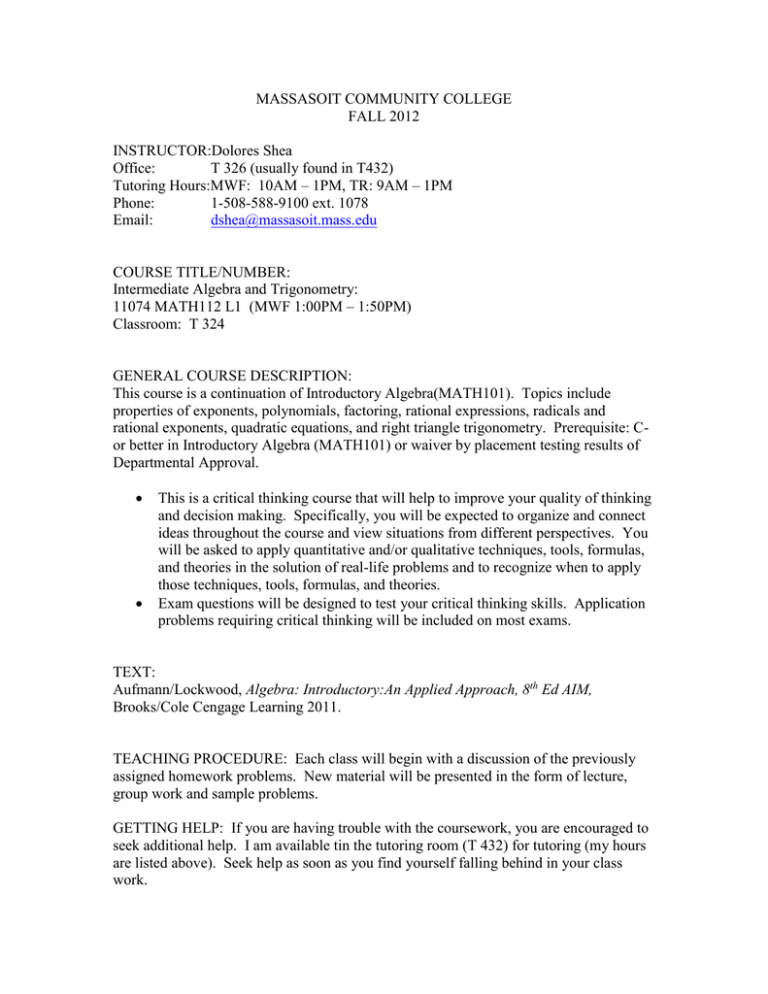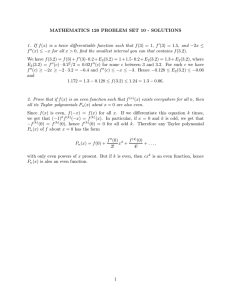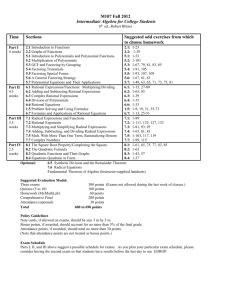MASSASOIT COMMUNITY COLLEGE FALL 2012 INSTRUCTOR:Dolores Shea
advertisement

MASSASOIT COMMUNITY COLLEGE FALL 2012 INSTRUCTOR:Dolores Shea Office: T 326 (usually found in T432) Tutoring Hours:MWF: 10AM – 1PM, TR: 9AM – 1PM Phone: 1-508-588-9100 ext. 1078 Email: dshea@massasoit.mass.edu COURSE TITLE/NUMBER: Intermediate Algebra and Trigonometry: 11074 MATH112 L1 (MWF 1:00PM – 1:50PM) Classroom: T 324 GENERAL COURSE DESCRIPTION: This course is a continuation of Introductory Algebra(MATH101). Topics include properties of exponents, polynomials, factoring, rational expressions, radicals and rational exponents, quadratic equations, and right triangle trigonometry. Prerequisite: Cor better in Introductory Algebra (MATH101) or waiver by placement testing results of Departmental Approval. This is a critical thinking course that will help to improve your quality of thinking and decision making. Specifically, you will be expected to organize and connect ideas throughout the course and view situations from different perspectives. You will be asked to apply quantitative and/or qualitative techniques, tools, formulas, and theories in the solution of real-life problems and to recognize when to apply those techniques, tools, formulas, and theories. Exam questions will be designed to test your critical thinking skills. Application problems requiring critical thinking will be included on most exams. TEXT: Aufmann/Lockwood, Algebra: Introductory:An Applied Approach, 8th Ed AIM, Brooks/Cole Cengage Learning 2011. TEACHING PROCEDURE: Each class will begin with a discussion of the previously assigned homework problems. New material will be presented in the form of lecture, group work and sample problems. GETTING HELP: If you are having trouble with the coursework, you are encouraged to seek additional help. I am available tin the tutoring room (T 432) for tutoring (my hours are listed above). Seek help as soon as you find yourself falling behind in your class work. SPECIAL ACCOMMODATIONS: “Students with disabilities who believe that they may need accommodations in the classroom are encouraged to contact the disability counselor as soon as possible. Students with learning disabilities should contact Andrea Henry, ext. 1805. Students with physical disabilities should contact Mary Berg, at ext. 1425. All students at the Canton campus should contact Mary Berg at ext. 2132. Students at the Middleboro campus should contact Andrea Henry at ext.1805.” NO MAKE-UPS WILL BE GIVEN on hour exams unless you know in advance that you will be absent and make arrangements with the instructor. The lowest test grade will be dropped, if you miss a test that will the grade that is dropped. No make-ups for quizzes (there are usually between 12 and 15 quizzes – I will take the best of 10). CLASSROOM BEHAVIOR: In order to create an effective learning and teaching environment, appropriate and courteous student classroom behavior is expected at all times. Disruptive or inappropriate behavior will not be tolerated. You are expected to fully comply with all college rules and regulations outlined in the Student Handbook. ATTENDANCE POLICY: A students’ attendance will count as 10% of their final grade. In order to receive a satisfactory grade in this class, a student should miss no more than five classes. The following absences will be equivalent to a numerical grade. 1absence = 93%; 2 absences =86%; 3absences=79%; 4 absences =71%, and 5 absences = 64%, 6 absences = 58% COURSE POLICIES AND REQUIREMENTS: 1. Students are encouraged to attend all classes. In the event that a student must miss a class, it is the responsibility of the student to do all homework assignments. 2. There will be four hand-in assignments which will be graded and counted as one test grade (10%). 3. There will be seven in class tests, but the lowest test grade will be dropped (60%). 4. Attendance will count as one test grade (10%). 5. 80% of the final grade will result from the test grades, hand-in assignments, and attendance. 6. Final Exam will count as two test grades (20%). GRADING SYSTEM: Grades are reported using a 4.0 system A 4.0 93 and above: Excellent C1.7 70-72 A3.7 90-92 D+ 1.3 67-69 B+ 3.3 87-89 D 1.0 63-66: Unsatisfactory B 3.0 83-86: Good D0.7 60-62 B2.7 80-82 F 0.0 Below 60: Failure C+ 2.3 77-79 I Incomplete is given at the C 2.0 73-76 discretion of the professor. COURSE TOPICS: (Test dates are tentative) I Chapter 4: Polynomials 4.1 Exponential Expressions: pp.194 odd# 1-59 odd 4.2 Multiplying Monomials: p. 198 #1-33 odd 4.3 Multiplying Polynomials: pp.204 #1-113 odd 4.4 Dividing Polynomials: p. 214 #1-25 odd, p. 215 #44, 57-60 all p.220 #3-21 odd Last day to drop or add a class without a grade is September 13, 2012 TEST: Wednesday : Sept. 19, 2012 4.2 Multiplication of Polynomials: p. 198 #35-77 odd 4.4 Division of Polynomials: p. 214 # 37- 91 odd Scientific Notation p. 216 #97-123 odd TEST: Wednesday : Sept. 28,2012. II Chapter 5: Factoring 5.1 Common Factors: p. 240 #1-41 odd 5.2 Factoring Polynomials of the form x 2 + bx + c: p. 246 #1-127 odd 5.3 Factoring Polynomials of the form ax 2 + bx + c: p. 241 #44-69 odd p. 257 #1-133, 139, 141odd No Class: Columbus Day: Monday: Oct. 8, 2012 5.4 Special Factoring: p. 262 #3-113 odd 5.5 Solving Equations: p. 2 #3-59 odd, 63,65,67,77,79,81,83 TEST: Friday: Oct. 17, 2012. III Chapter 6: Rational Expressions 6.1 Multiplication and Division of Rational Expressions: p. 292 #3-83 odd 6.3 Addition and Subtraction of Rational Expressions: p. 305 #1-77 odd 6.4 Complex Fractions: p. 312 #1-17 odd 6.5 Rational Equations: p. 316 # 23-35 odd, 6.8 Application Problems: p. 336 #29,39 p. 340 #1,3,5 TEST: Wednesday: Nov. 5, 2012 NO CLASS: Nov. 12, 2012 LAST DAY TO WITHDRAW FROM A CLASS: Nov. 13, 2012 NO CLASS: THANKSGIVING RECESS: Nov. 22 – 25, 2012 IV Chapter 10: Radical Expressions 10.1 Introduction to Radical Expressions: p.484 #3 – 75 odd 10.2 Addition and Subtraction of Radical Expressions: p.484 #3-49 odd 10.3 Multiplying and Dividing Radical Expressions: p. 494 #1 – 69 odd 10.4 Solving Radical Equations: p. 500 #1-17 odd TEST: Dec. 3, 2012 V Chapter 11: Quadratic Equations 11.1 Solving Quadratic Equations by Factoring or by Taking Square Roots p. 549 #1-33 odd 11.3 Solving Quadratic Equations by Using the Quadratic Formula p. 551 #83-97 11.4 Solving Equations that are Reducible to Quadratic Equations: p. 563 #3-29 odd 11.5 Applications of Quadratic Equations: p. 569 #19-27 odd, p. 573 #1-11 odd TEST: Dec 12, 2012 *Last Day of Class: Dec 14, 2012 FINAL EXAM: Dec. 17, 2012 at 1PM – 3PM INSTRUCTIONAL OBJECTIVES: COURSE OUTCOMES At the end of this course, students will be able to Apply the properties of rational exponents in order to facilitate the use of these properties in further topics and problems in mathematics. OUTCOMES ACTIVITIES 1. Simplify exponential expressions using: bn bm b n m a. b n m b. b nm c. ab d. bn bn m bm n a n bn when b 0 n an a n b b when b 0 b 1 when b 0 f. 1 bn n b g. when b 0 (CT,QS) 2. Translate between exponential and radical forms using: e. 0 1 a. b n n b when n is a positive integer greater than 1 m b. Perform the operations of addition, subtraction, multiplication, and division on polynomials in order to apply these skills to factoring, solving equations, and problem solving. b n n bm b n m when n is a positive integer greater than 1 and m is any integer. (CT,QS) 1. Find sums and differences of polynomial expressions. (W,R,CT,QS) 2. Multiply polynomial expressions including: monomial by monomial, monomial by polynomial, and polynomial by polynomial. (W,R,CT,QS) 3. Find special products including: square of a binomial and binomial times conjugate. (W,R,CT,QS) 4. Divide a polynomial by a monomial. (W,R,CT,QS) 5. Solve applied problems using operations on polynomials. (W,R,CT,QS) Solve various types of factoring problems in order to apply these skills to further topics and problems in mathematics. Simplify and perform operations on rational expressions in order to apply these skills to further topics and problems in mathematics. Demonstrate the ability to simplify and perform operations with radicals in order to apply these skills to further topics and problems in mathematics. Solve quadratic equations in order to apply these skills to further topics and problems in mathematics. Demonstrate an understanding of the six trigonometric functions of an acute angle in a right triangle in order to use trigonometry appropriately to solve applied problems in mathematics and related courses. Strengthen Core Competencies** in order to increase success in this and other courses and in the workplace. 1. Factor a monomial from a polynomial. (W,R,CT,QS) 2. Factor by grouping. (W,R,CT,QS) 2 3. Factor a trinomial of the form x bx c. (W,R,CT,QS) 2 4. Factor a trinomial of the form ax bx c. (W,R,CT,QS) 5. Factor the difference of two perfect squares. (W,R,CT,QS) 6. Factor a perfect square trinomial. (W,R,CT,QS) 7. OPTIONAL: Factor the sum or difference of two cubes. (W,R,CT,QS) 8. Use multiple factoring techniques to factor completely any expression. (W,R,CT,QS) 9. Solve equations by factoring. (W,R,CT,QS) 10. Solve applied problems using factoring. (W,R,CT,QS) 1. Simplify rational expressions (reduce to lowest terms). (CT,QS,R) 2. Multiply and divide rational expressions. (CT,QS R) 3. Add and subtract rational expressions with like denominators and with unlike denominators. (CT,QS R) 4. Solve rational equations. (CT,QS,R) 5. Simplify complex fractions. (CT,QS,R) 6. Solve applied problems. (CT,QS,R) 1. 2. Simplify radical expressions. (CT,QS,R) Add, subtract, and multiply radical expressions. (CT,QS,R) 3. Rationalize denominators (monomial square root denominators and binomial square root denominators). (W,R,CT,QS) 4. Solve radical equations. (W,R,CT,QS) 5. Solve applied problems. (W,R,CT,QS) 1. Solve by factoring. (CT,QS) 2. Solve by the square root method. (CT,QS) 3. Solve by the quadratic formula. (CT,QS) 4. OPTIONAL: Solve by completing the square. (CT,QS) 5. Solve applied problems. (CT,QS,W,R) 1. Use the basic definitions to find the trigonometric function values of a given acute angle in a right triangle. (CT,QS, R) 2. Use a scientific calculator or trigonometric tables correctly. (CT,QS,R,TS) 3. Solve right triangles. (CT,QS, R) 4. Solve applied problems. (CT,QS, R) Referenced above **Indicate the Core Competencies that apply to the outcomes activities and assessment tools: Critical Thinking (CT); Technology Skills (TS); Oral Communications (OC); Quantitative Skills (QS); Reading (R); Writing (W).

![ )] (](http://s2.studylib.net/store/data/010418727_1-2ddbdc186ff9d2c5fc7c7eee22be7791-300x300.png)


